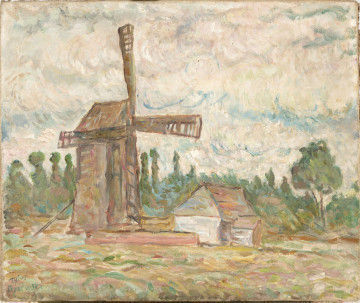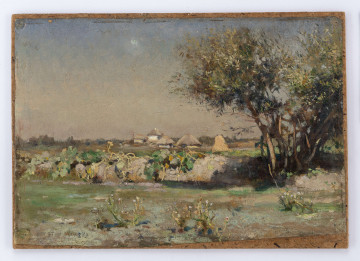
Cottages
National Museum in Lublin
Part of the collection: Genre scenes
Franciszek Kostrzewski is one of the progenitors of realism in Polish art. His works are devoted to the life of towns and villages, of which he was a close observer. Rozmowa księdza z dzieci [Conversation of a Priest with Children] (1856) comes from the period when the artist still devoted himself to painting, abandoned after 1870 in favour of drawing and work as an illustrator. It was in the 1850s that Cyrk na Saskiej Kępie [Circus in Saska Kepa] (1852) and Chłopi w karczmie [Peasants in the Tavern] (1854), considered among the best works in the artist's legacy, were created. Set against the background of the native, picturesque landscape, the genre scenes, whose characters are small inhabitants of villages, concentrate all the characteristic features of Kostrzewski's art. Its principles were developed during his studies at the Warsaw School of Fine Arts in the atelier of J. F. Piwarski. A circle of friends emerged among the first adepts (including F. Kostrzewski, J. Kossak, W. Gerson, H. Pillati), called the Marcin Olszyński Group after its leader, considered the first artistic bohemia. It was of great importance for forming a realistic direction, programmatically departing from the academic rules still governing Polish art, idealised portrait and landscape represented by their teacher, C. Breslauer. Attention was drawn to the life of simple folk, their customs and behaviour, shown without romantic emphasis. The friends took ‘walking tours’ around the country for learning. A vital element of the trips were open-air studies. Participants recorded their observations in drawings and paintings, revealing the reality and specificity of places and characters. Kostrzewski was fond of the Kielce landscape. He spent his childhood in the Sandomierz countryside, later staying temporarily with wealthy landowners, including the patron and collector T. Zieliński.
There are echoes of admiration of the Dutch painting of the 17th century and the Barbizonians in the artist's paintings. The inspirations are visible mainly in genre scenes, situated in dark interiors, and in landscapes with staffage, in which a warm, golden landscape is as essential as the anecdote presented.
Contemporaries described Kostrzewski as a man who loved people and the pleasures of life, a devoted and kind teacher. The most outstanding pupil turned out to be J. Szermentowski, who remained faithful to the artistic testament of the master.
Bożena Kasperowicz
Author / creator
Dimensions
cały obiekt: height: 59 cm, width: 43 cm
Object type
painting
Technique
oil technique
Material
canvas, oil-based paint
Creation time / dating
Creation / finding place
Owner
The National Museum in Lublin
Identification number
Location / status

National Museum in Lublin

1936
National Museum in Lublin

1880 — 1900
National Museum in Lublin
DISCOVER this TOPIC
Museum of King Jan III's Palace at Wilanów
DISCOVER this PATH
Educational path